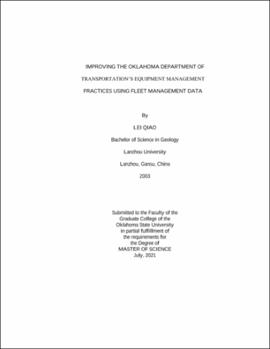| dc.contributor.advisor | Liu, Tieming | |
| dc.contributor.advisor | Shan, Yongwei | |
| dc.contributor.author | Qiao, Lei | |
| dc.date.accessioned | 2022-01-21T19:33:55Z | |
| dc.date.available | 2022-01-21T19:33:55Z | |
| dc.date.issued | 2021-07 | |
| dc.identifier.uri | https://hdl.handle.net/11244/333829 | |
| dc.description.abstract | The departments of transportation in the U.S. typically possess a big fleet of vehicles and equipment. The equipment management face pressure to reduce cost and improve efficiency of utilization. Oklahoma Department of Transportation (ODOT) has approximately 4,300 pieces of equipment, with equipment purchase year ranging from 1964 to the present. A lot of the equipment has already exceeded its useful life and many others are running under suboptimal conditions with an increase in operating costs due to equipment aging and deterioration. Equipment replacement decisions could play very important role in controlling the cost, however, there is a lack of decision support tool and decisions are purely dependent on fleet managers' experience. Other than replacement with purchasing, state DOTs may use rent or lease to augment its existing fleet. The two major sources of costs of ownership cost (mainly as depreciation) and operating costs traditionally are estimated by empirical methods with many assumptions and a lot of errors could be involved. This research directly addresses the need of ODOT. The overarching goal of this study is to help ODOT accurately estimate equipment costs and improve its equipment management practices using the data recorded in its equipment fleet management system. New entity-relational database was setup with SQL procedures to calculate the equipment rental rates for all equipment class codes. Advanced data analytics of life cycle cost analysis, exploratory data analysis, and dynamic programing models were applied in MySQL workbench and Python notebook platforms to inform equipment replacement policies and rent-leasing strategies for specific class codes. Class code 5355 (Front-End Loader) and 5385 (1/2 Ton Fleetside Pickup) were selected as example demonstration for hourly-charged and mile-charged types. There are very similar cost-age patterns between the two classes of 5355 and 5385 and cost rates are in decreasing trend (statistically significant) for both classes in the life cycle cost analysis. With the application of replacement strategies by the dynamic programing model, the cumulative total cost could be reduced by roughly $ 7,000 and $ 8, 500 on average within the period from 2011 to 2019 for the optimized equipment in the class code 5355 and 5385, respectively. In comparison to the rental prices from different online agencies, 10% (7/70) of current equipment in class code 5355 and less than 1% (12 out of 449) of current equipment in class code 5385 are suggested for renting rather than owning. | |
| dc.format | application/pdf | |
| dc.language | en_US | |
| dc.rights | Copyright is held by the author who has granted the Oklahoma State University Library the non-exclusive right to share this material in its institutional repository. Contact Digital Library Services at lib-dls@okstate.edu or 405-744-9161 for the permission policy on the use, reproduction or distribution of this material. | |
| dc.title | Improving the Oklahoma Department of Transportation's equipment management practices using fleet management data | |
| dc.contributor.committeeMember | Yao, Bing | |
| osu.filename | Qiao_okstate_0664M_17305.pdf | |
| osu.accesstype | Open Access | |
| dc.type.genre | Thesis | |
| dc.type.material | Text | |
| dc.subject.keywords | cost reduction | |
| dc.subject.keywords | data analytics | |
| dc.subject.keywords | dynamic programing | |
| dc.subject.keywords | equipment replacement | |
| dc.subject.keywords | optimization | |
| thesis.degree.discipline | Industrial Engineering and Management | |
| thesis.degree.grantor | Oklahoma State University | |
